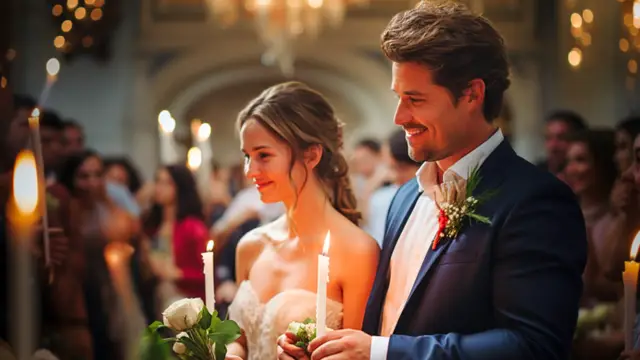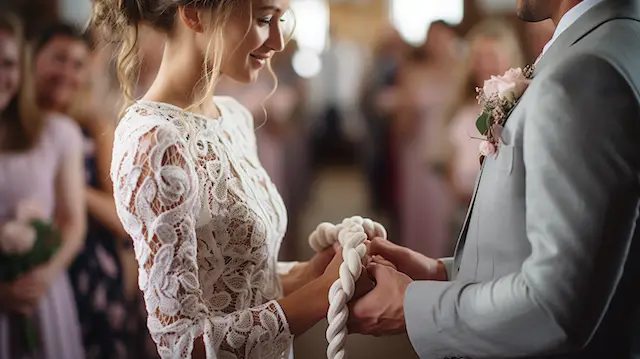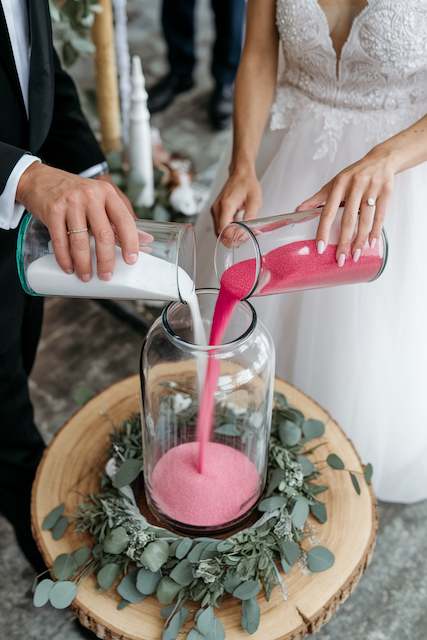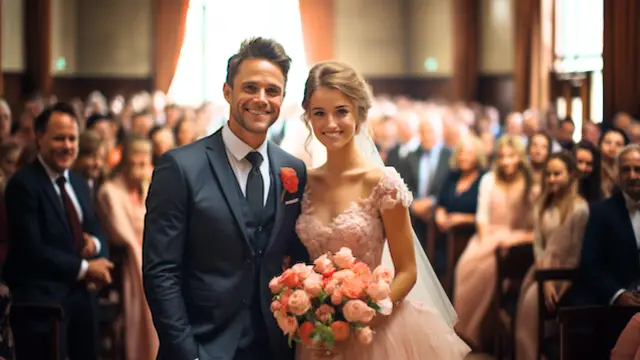Unity Ceremonies: Best Picks for Personalizing Your Wedding
Unity ceremonies are a beautiful and symbolic part of many weddings. They represent the joining of two lives into one and can be a deeply personal and meaningful aspect of the celebration.
These ceremonies can take many forms and vary across different cultures and traditions.
From traditional to modern, cultural to unique, there’s a unity ceremony for every couple.
They often include a statement of commitment to one another and their shared future, creating a beautiful and meaningful aspect of the wedding day.
A unity ceremony often takes place after the exchange of vows but before the rings. It can involve various symbolic acts such as lighting candles, mixing sand, or planting a tree.
Unity Ceremonies: At A Glance
- Purpose: Symbolizes the joining of two lives into one, offering a deeply personal touch to wedding celebrations.
- Variety: From traditional (Unity Candle, Sand Ceremony) to modern (Unity Painting, Time Capsule), there’s a unity ceremony for every couple.
- Timing: Typically takes place after the exchange of vows but before the exchange of rings.
- Personal Touch: Can be tailored to fit different relationships, family dynamics, and cultural backgrounds.
- Key Advice: Choose a ceremony that resonates with both partners and consider incorporating family and friends for added significance.
Let’s dive into the world of unity ceremonies and explore the various options available.

Understanding Unity Ceremonies
When planning your wedding, you want to select a unity ceremony that truly resonates with you and your partner, as it will become a cherished memory and a symbol of your marriage.
Your wedding day is about the two of you, so choose a unity ceremony that feels authentic to your relationship and resonates with both of you.
Essence of Unity Ceremonies
Symbolism in Unity Ceremonies
Unity ceremonies are deeply symbolic, incorporating elements representing the couple’s relationship and shared commitment.
- Combining two flames into one to symbolize your union (Unity Candles)
- Intermingling different colored sand into a single container signifies the inseparable blending of the couple’s lives (Sand Ceremony)
- Tying together hands to symbolize connection to each other (Handfasting Ceremony)
- Pouring wine from separate vessels to symbolize a shared experience and mutual support (Wine Ceremony)
- Symbolizing your growth and deep roots over time (Tree Planting Ceremony)
Conveying Love and Commitment
Your vows and the symbolic rituals performed in these ceremonies are a beautiful way to show your devotion and the bond you share.
Reflecting Faith and Tradition
Unity ceremonies can also be a beautiful connection between faith, tradition, and cultural backgrounds. By incorporating elements from your family histories, religious beliefs, or cultural customs, you can create a ceremony that truly showcases the significance of faith and tradition in your relationship.
For Different Relationships
Unity ceremonies can be adapted to different relationships and family dynamics.
- Family Unity Ceremony: Include children or other family members.
- Blended Family Sand Ceremony: Symbolize the joining of two families.
- Same-Sex Unity Ceremony: Celebrate love in all its forms.
These options ensure that everyone feels included and celebrated.
Traditional Unity Ceremonies
These are the ceremonies that have stood the test of time. They are often seen as the backbone of unity ceremonies and include:
Unity Candle Ceremony
In a Unity Candle Ceremony, you and your partner each light a small individual candle, representing your separate lives. Then, you both use these individual candles to light one larger unity candle, symbolizing the merging of your lives together. This ceremony is a beautiful visual representation of your commitment.
Handfasting Ceremony

The Handfasting Ceremony is an ancient Celtic ritual in which your hands are bound together with a ribbon or cord. As your hands are tied, you exchange vows and promises, signifying the binding of your lives together. Handfasting has become a popular addition to weddings for couples interested in adding traditional or cultural elements.
Sand Ceremony

In a Unity Sand Ceremony, you and your partner each pour sand from separate containers into one central vessel. This act represents the blending of your lives together. You might use sand in different colors to symbolize your individuality and each person’s uniqueness in the relationship.
Lasso Ceremony
The Lasso Ceremony is a Hispanic tradition in which a rope or rosary is looped around the couple, forming a figure-eight shape. This symbolizes the infinite bond shared by you and your partner. The Lasso is typically removed by the officiant and given to the couple as a keepsake.
Tree Planting Ceremony
During a Tree Planting Ceremony, you and your partner plant a tree together using soil from each of your hometowns or places of significance. This act represents the growth and nurturing of your relationship, as the tree symbolizes your unity and the future you will share.
Jumping the Broom
Jumping the Broom is an African-American tradition and symbolizes the sweeping away of the past and the beginning of a new life together. During the ceremony, family members or friends typically hold a broom, and you and your partner jump over it to signify moving into this new stage of your lives.
Rose Ceremony
In a Rose Ceremony, you and your partner exchange roses, symbolizing the giving and receiving of love. This unity ceremony can be made more special by incorporating family members. For example, you could present roses to your parents or future in-laws as a sign of gratitude and affection.
Wine Box Ceremony
Finally, the Wine Box Ceremony involves you and your partner placing love letters and a bottle of wine into a wooden box during the wedding ceremony. You can then seal the box and open it on a significant anniversary, such as your fifth or tenth year, to read the letters and toast to your love. This unity ceremony symbolizes the strength and longevity of your commitment.
Wines Ceremony Vs. Wine Box Ceremony
The Wine Ceremony and Wine Box Ceremony are two distinct rituals that can be included in a wedding, but they have different meanings and procedures. Here’s a table to explain the differences:
| Aspect | Wine Ceremony | Wine Box Ceremony |
|---|---|---|
| Meaning | Symbolizes the blending of two lives into one, much like wine blends flavors. | Symbolizes the preservation of love and a promise to open the box during a significant anniversary or if the couple ever needs a reminder of their vows. |
| Procedure | Both partners pour wine from two separate glasses into a single glass and then drink from it together. | The couple places a bottle of wine and love letters to each other in a box and seals it during the ceremony. |
| Timing | Typically performed during the wedding ceremony. | The box is usually opened on a significant anniversary or at a time when the couple needs to reconnect. |
| Accessories | Two wine glasses, one shared glass, and wine. | A wooden box, wine bottle, love letters, and often a way to seal the box (e.g., hammer and nails). |
| Symbolism | Represents unity, sharing, and the blending of lives. | Represents the lasting commitment, the aging of a fine wine, and the growth and deepening of love over time. |
| Inclusion of Others | Can include family or friends in the pouring to symbolize the blending of families. | Often just involves the couple, but can include letters from family or friends to be read in the future. |
Cultural Ceremonies
In this section, we will explore various unity ceremonies from different cultures around the world. Each of these rituals holds significance and meaning to the respective traditions.
Chinese Tea Ceremony
The Chinese Tea Ceremony is an essential part of traditional Chinese weddings. During this ceremony, the bride and groom serve tea to their parents, grandparents, and other family members. This ritual symbolizes respect towards the couple’s families and the joining of two families through marriage. The tea typically contains sweet ingredients, symbolizing a sweet life together for the newlyweds.
Celtic Handfasting
In the Celtic Handfasting tradition, the couple’s hands are bound together with a symbolic cord, ribbon, or cloth during the wedding ceremony. This act represents the unity and commitment of the couple. Depending on their colors and materials, the various cords used in handfasting can have different meanings, such as love, honor, and strength.
Indian Seven Steps
In many Hindu and Indian weddings, the Seven Steps ritual plays a significant role. The couple walks around a sacred fire, taking seven steps together, each representing a distinct marital vow. The vows include aspects like nourishment, strength, prosperity, happiness, progeny, health, and friendship, which are essential for a successful and lasting marriage.
Jewish Glass Breaking
At the end of a Jewish wedding ceremony, the groom breaks a glass wrapped in cloth with his foot. This act symbolizes the destruction of the ancient Temple in Jerusalem and the fragility of human relationships. The Jewish Glass Breaking serves as a reminder that the couple must work together to build a solid and enduring partnership. The guests then exclaim, “Mazel Tov!” congratulating the newlyweds and wishing them happiness in their new life together.
Modern & Unique Ceremonies
For those looking to add a creative twist, modern and unique ceremonies like Unity Painting, Time Capsule, and Unity Puzzle Ceremony can be a fun option.
Unity Painting: Showcase your creativity as a couple by unity painting during your ceremony. Each partner chooses a paint color and, together, you create a one-of-a-kind work of art that symbolizes your two lives blending into one. This masterpiece can become a cherished keepsake for years to come.
Time Capsule Ceremony: In a time capsule ceremony, each partner contributes meaningful items or written memories to a box, which is then sealed, buried, or stored to be reopened on a future anniversary. This ceremony provides a tangible reminder of your love story, allowing you to reminisce and reflect on your journey together.
Puzzle Ceremony: For couples who love a challenge, consider the unity puzzle ceremony. Each partner has their own uniquely shaped puzzle piece, which they fit together during the ceremony, symbolizing the joining of their two lives. This can be a beautiful and meaningful keepsake for your home.
No matter which modern and unique ceremony you choose, tailoring it to your relationship is essential to capture the essence of your love and commitment.
Incorporating Family and Friends
Unity ceremonies are a beautiful way to symbolize the joining of two people in marriage. To truly make the experience memorable and meaningful, consider incorporating family and friends into the ceremony.
For couples with children, you might consider having your child or children participate in lighting a unity candle. Each family member holds a lit candle, and together, you light one larger candle, symbolizing the joining of your lives and the formation of a new family unit.
Another option is to involve your mothers as witnesses during the handfasting ceremony.
Having mothers participate in this ritual acknowledges their crucial role in your lives and the love and support they provide.
Additionally, guests can also be involved in your unity ceremony. For example, you can pass around a special object, like a stone or a piece of fabric, for everyone to hold and imbue with their well-wishes and positive energy. This object will then hold the collective energy and love from all your guests, creating a tangible reminder of your community’s support throughout your marriage.
Personalizing Your Unity Ceremony
The unity ceremony can be customized to best represent your relationship and the blending of your lives.
- Discuss your vision for the unity ceremony with your wedding officiant. They may have valuable suggestions and can help guide you in choosing the best options for your ceremony.
- Incorporate love letters or notes from each other. These can be read aloud during the ceremony or even sealed in a box, creating a time capsule to be opened on a future anniversary.
- Involve your family and friends. You could invite them to participate by contributing small tokens symbolizing their love and support for your marriage.
- Think outside the box by choosing unique symbols, materials, and keepsakes representing the two of you as a couple (earth, water, air, and fire).
Heritage-Based Unity Ceremonies
Heritage-based unity ceremonies are wonderful ways to incorporate your cultural traditions into your wedding day. Here are five examples:
- Sake Sharing Ceremony: In Japanese weddings, a Sake Sharing Ceremony, also known as San San Kudo, is held. The couple and their parents take turns to drink sake, signifying the union of the two families.
- Las Arras Coin Ceremony: In this Latin American tradition, the groom gives the bride 13 coins, symbolizing his commitment to providing for the family and the shared financial responsibility in their marriage.
- Veil and Cord Ceremony: In Filipino weddings, a veil is placed over the couple, and a cord in figure eight is laid on top, symbolizing lifelong fidelity and the binding together of the couple.
Planning & Tips for Unity Ceremonies
Think about the theme of your wedding. The unity ceremony should complement the overall theme of your big day, making it a seamless and meaningful addition to the celebration.
Consider the special location for your unity ceremony, whether it’s indoors or outdoors. If you’re having an outdoor ceremony, a Tree Planting Ceremony could be perfect, but a Unity Candle Ceremony will not work.
Coordinate with your wedding planner and officiant to find the best time for your unity ceremony within wedding ceremony programming. Usually, unity ceremonies occur during the main wedding ceremony, but the exact timing should be coordinated with the officiant and any other elements, like music or readings.
Carefully select unity ceremony music that complements the theme and creates a meaningful atmosphere. If you’re unsure what music to choose, consult your officiant, wedding planner, or musician for recommendations.
Explore unity ceremony alternatives to find one that resonates with both you and your partner. Some popular alternatives include releasing a wish lantern.
Write your own vows, selecting meaningful quotes or incorporating cultural and family traditions.
Don’t forget the logistics:
1. setting up a table for the ceremony
2. make sure you have all the necessary supplies
3. inform your photographer of any specific moments or angles you’d like them to capture
Frequently Asked Questions
What are some popular types of unity ceremonies?
There are several popular types of unity ceremonies that couples can choose from to symbolize their union. Some common ones include the sand ceremony, handfasting, unity candle, water ceremony, and wine ceremony. Each option carries a symbolic meaning and can be personalized to suit the couple’s preferences and beliefs.
How long does a unity ceremony typically last?
The duration of a unity ceremony can vary depending on the type of ceremony and how elaborate the couple chooses to make it. Generally, though, most unity ceremonies last between 5 to 10 minutes. It’s important to keep the ceremony brief and focused on the symbolic meaning behind it.
What is the symbolism behind the sand unity ceremony?
The sand unity ceremony involves the couple pouring individual containers of sand into a single, larger container, symbolizing the blending of their lives and becoming one. The different colors of sand represent each person’s individuality, while the mixed sand signifies the inseparable bond formed in marriage.
Are there unique unity ceremony ideas for Christian weddings?
Yes, there are several unique unity ceremony ideas that can be incorporated into Christian weddings. Some ideas include the Unity Cross ceremony, the Cord of three strands ceremony, or the foot-washing ceremony. Each option highlights different aspects of Christian beliefs and can be customized to fit the couple’s preferences.
What are some suggestions for songs to play during a unity ceremony?
Choosing the right song for your unity ceremony can help set the mood and make the moment even more meaningful. Some popular suggestions include “A Thousand Years” by Christina Perri, “Can’t Help Falling in Love” by Elvis Presley, “Marry Me” by Train, or “All of Me” by John Legend. It’s important to choose a song that resonates with you and your partner, reflecting the bond you share and the commitment you’re making in the ceremony.


